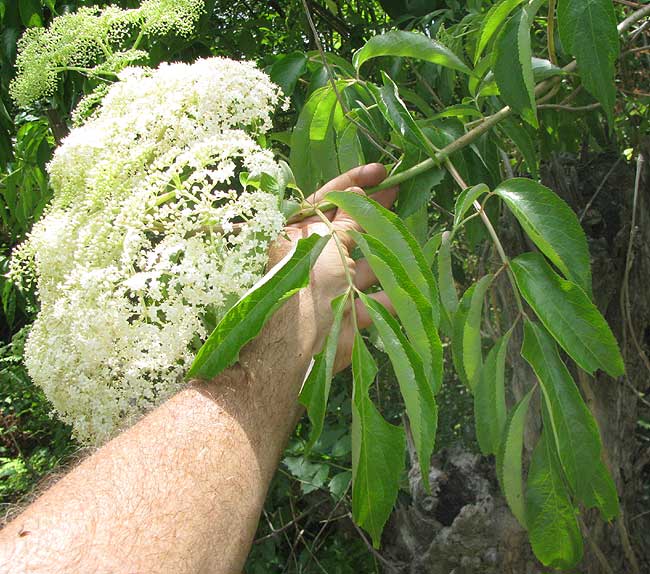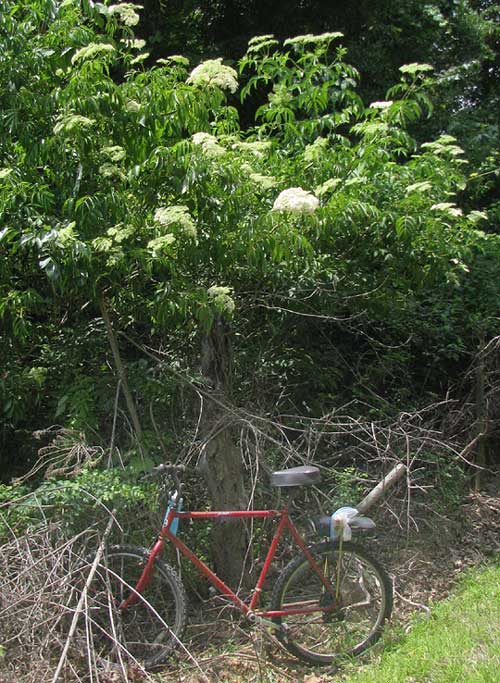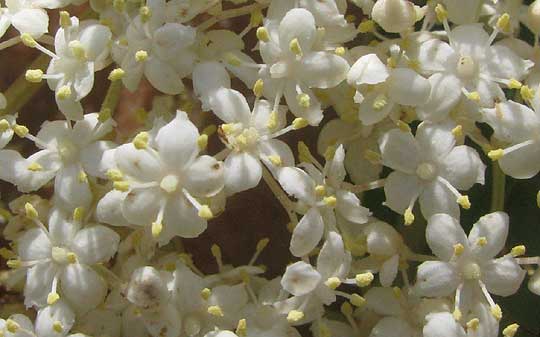Excerpts from Jim Conrad's
Naturalist Newsletter

from the May 13, 2012 Newsletter issued from the woods of the Loess Hill Region a few miles east of Natchez, Mississippi, USA
ELDERBERRIES FLOWERING
A plant using the strategy of clustering many small, white flowers into large heads to attract pollinators in the current ocean of green hues is the American Elderberry, whose robust panicles and pinnately compound leaves are shown above. Those flowers are on the plant below standing over 13 feet tall (4m):

And look at how neatly the little flowers hold side-by-side at the panicles' surface below:

All my life I've thought of American Elderberries as being *SAMBUCUS CANADENSIS in the Honeysuckle Family, the Caprifoliaceae. But now about half the sources consulted regard American Elderberry as a subspecies of the European one, classifying it as Sambucus nigra ssp. canadensis in the Moschatel Family, the Adoxaceae, which I've never heard of.
One reason that's interesting is because the European species is popularly used as food and medicine. The fruits do contain impressive levels of anthocyanins, vitamins A and C and are a good source of calcium, iron and vitamin B6. In Europe various herbal remedies contain elderberry products, the supposed cures being too many to list. Maybe now when Americans see that our plants are essentially the same as the honored European one, our species will gain more respect.
Already while researching these words Google offered me an 8oz. bottle of "Nature's Way Sambucus Kids Syrup" for $14 -- Sambucus being the elderberry's genus name.
from the August 15, 2004 Newsletter issued from the woods of the Loess Hill Region a few miles east of Natchez, Mississippi, USA
ELDERBERRY FLAPJACKS
This was the week when Elderberries reached their peak of perfection. In early July ten-foot-high bushes beside the plantation's gate issued dinner-plate-size, flat-topped inflorescences of tiny white flower. Most of the time since then the fruits have been hard, green, BB-size things, but now they are so dark purple they might as well be black, glossy in the sunlight, juicy, and the size of small peas.
A single Elderberry fruit isn't much to look at, but fruit clusters can be the size of basketballs. Branches bearing such impressive burdens bow earthward like so many smiling Confuciuses in flat-topped, dark purple hats. When the sun is heaviest and the air is hottest and most humid, you stand there looking at the great gobs of fruits and you know that, both literally and in an esthetic sense, there just couldn't be a more perfect crystallization of wild, unrestrained Augustness.
Elderberry fruits look like good eating but their taste is too rank to deal with. At least, right off the bush you don't want to nibble more than a few. It's another matter if you take the time to dry them. My solar cooker does a good job of that, but an old screen door set atop some cinderblocks in the sunlight should accomplish the same thing. During the drying process first they become like small, gummy raisins but if you let them dry long enough -- a full day on my cooker -- they become like smallish peppercorns, hard and crunchy. The drying process undoes most of the green elder taste, but the results are still pretty strong for most people's palates. If you ever get into a head where you like raunchy-smelling cheese, you'll probably love dried elderberries with their minor-key flavor tinted with Schadenfreude purple.
They're not bad just to nibble on, and I've read that you can make pies from them, treating them like raisins when making raisin pie. I haven't tried that sugary dish because of my hypoglycemia. I have indeed made deep-purple flapjacks with just flour, cornmeal and a couple cups of dried elderberries, and it was good. The tiny seeds were crunchy as in fig newtons, and the taste was something any person who likes hard sunlight and open spaces might like. I also have a recipe for "Elderberry Chutney," in case anyone is interested. Of course you can make wine from just about any fruit, and Elderberry wine used to enjoy favor in certain parts of the country.
To collect the fruits I hold a large aluminum pan of the type turkeys are baked in beneath a big cluster and not-too-roughly wiggle my fingers among the fruits, knocking the ripe ones into the pan. Once you get a mess you need to remove the few stems still attached to the fruits, and remove the green chinch bugs, who have a special fondness for elderberries.
You get purple fingers from this exercise but somehow that's part of the fun.